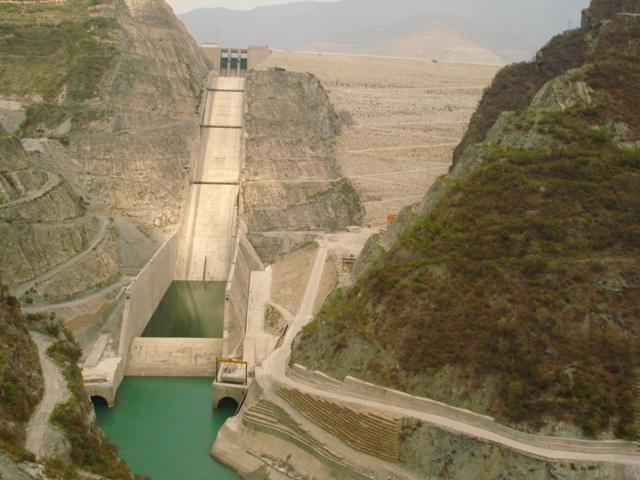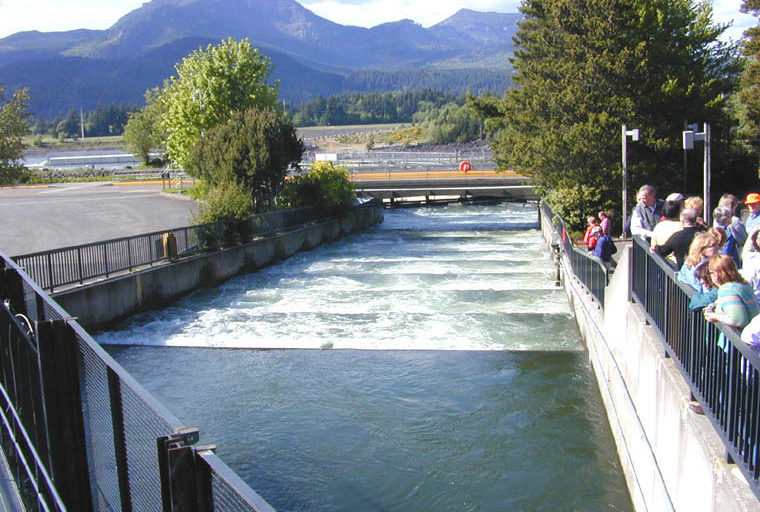- Dams create obstructions across rivers inhibiting the migration of fish and other aquatic species leading to the isolation of habitats, which can affect the genetic structure of populations.
- Close genetic relationships were seen between golden mahseer populations in Bhagirathi and Ganga rivers while notable genetic differences were observed among Alaknanda and Yamuna populations.
- The authors proposed establishing microscale protected areas near breeding sites of golden mahseer to enhance viable populations and constructing fish passes to ensure migration and maintain gene flow.
Scientists have found close genetic relationships between populations of the golden mahseer, an iconic freshwater fish in Indian rivers Bhagirathi and Ganga, while significant genetic differentiation was observed between Alaknanda and Yamuna populations.
“The populations of golden mahseer in these rivers must be the focus of a conservation plan to maintain the genetic diversity within the basin,” stressed Sandeep Kumar Gupta and S.A. Hussain, senior author of the study and scientist at the Wildlife Institute of India.
In the study, conducted by scientists from the Wildlife Institute of India, the authors proposed establishing a microscale protected area near breeding sites of golden mahseer and the construction of a fish pass in dams to allow dispersal of golden mahseer and maintain genetic connectivity.
The golden mahseer (Tor putitora), known for their striking golden hues, are large-bodied fish that have reached weights greater than 50 kg and lengths of over 200 centimetres. Consequently, they are popular as sport fish. Found in cold-water habitats of the Himalayan region, the presence of the endangered golden mahseer, a flagship species, indicates healthy freshwater ecosystems. The fish is very sensitive to change in water temperature; therefore, small climatic fluctuation may lead to a change in its genetic structure.
Some fish species undertake long-term or short-term small-scale migrations within and among rivers at certain phases of their life cycle, said Gupta. Golden mahseer occur in fast-moving waters such as rapid streams with a rocky bottom and riverine pools. During their breeding period, adults migrate from the foothills to the upper reaches of rivers and tributaries for spawning typically in gravel substrates. Individuals grow at an average rate of about 10 cm per year.
Golden mahseer is “naturally distributed” throughout the rivers (and associated reservoirs) of the south Himalayan drainage (the Indus, Ganges-Yamuna and Bramaputra) from Pakistan (also unverified reports from Afghanistan) in the west to Myanmar in the east. Records are also available from several river systems and associated reservoirs in the Mahanadi (previously recorded as Tor mosal mahanadicus) and the Krishna (as a consequence of captive breeding and stocking from hatcheries) located south of the Himalayan landscape.
Dams and barrages across rivers disrupt ‘longitudinal connectivity’ or the free flow of water, sediment, and organisms. These barriers limit the dispersal of species and create isolated microhabitats. Previous studies have shown that the barrier effect caused by Tehri dam, located at the confluence of Bhagirathi and Bhilangana, has resulted in a decline in the populations of mahseer upstream of Bhagirathi river, according to a 2012 WII report. A citizen’s report, ‘Rejuvenating Ganga‘ released in 2019 claimed that the Ganga is being “bled at almost 1000 diversion points” in its basin. And still more diversionary proposals are on the drawing boards.
The Alaknanda originates from two glaciers, the Satopanth and Bhagirath Kharak glaciers (elevation 3800 m). The Bhagirathi originates from Gomukh, (elevation 3920 m), the snout of the Gangotri glacier. After flowing for approximately 225 km, these two rivers join at Devprayag and are subsequently known as the Ganga. The Ganga is the largest river in India. It has a length of 2525 km. Two major dams, at Tehri and Koteshwar, have been constructed across the Bhagirathi, whereas the Srinagar dam is constructed across the Alaknanda in Uttarakhand.
Gupta and Hussain’s team, which included researchers Prabhaker Yadav and Ajit Kumar, investigated how river connectivity and structures such as dams and barrages affect the population genetic structure, gene flow, and demography of golden mahseer populations found in four Himalayan rivers, the Ganga, and its tributaries, Bhagirathi, Alaknanda, and Yamuna. They focused on a gene called Cytochrome b found in mitochondria, maternally-inherited organelles, and tracts of repetitive DNA sequences called microsatellite markers.

Genetic diversity of river populations
The team found a structuring pattern in golden mahseer populations at the microsatellite level with three genetic clusters in the Ganga-Bhagirathi, Alaknanda and Yamuna. Close genetic relationships were observed between Bhagirathi and Ganga populations whereas significant levels of genetic differentiation were seen among Alaknanda and Yamuna populations. “The close genetic relationship of Bhagirathi and Ganga populations might be due to the high rate of unidirectional migration of golden mahseer from the Bhagirathi river (to the Ganga),” said Gupta.
This movement, he explained, might be “due to the availability of high water levels in the upper region of Tehri dam across the Bhagirathi that replenishes the major golden mahseer stock in the Ganga river.” Gupta explained that high water levels at Tehri provide a suitable habitat with a large population of golden mahseer and also help in their migration downstream.

A low rate of migration of golden mahseer was observed from the Alaknanda into the Ganga and isolation of stocks in the upstream region of the Alaknanda. Gupta explains that this may be because of the presence of the Srinagar dam across Alaknanda with parallel inside tunnel and channel. “It resulted in a low water level in the downstream of the dam that leads to a patchy area and unfavorable conditions for the mahseer.”
Physical differences in flow, depth, and other features in a river result in a diverse range of potential niches for aquatic organisms. The distributions of fish and other organisms tend to form a patchy mosaic that shifts and responds dynamically to high-water events, explained Gupta. For fish, he said a patchy area signifies “fragmented niche due to low water level and unsuitable habitat.”
The role of micro-protected areas and fish passes
The authors suggested establishing microscale protected areas (PAs) or eco-sensitive zones (ESZ) near the breeding sites of golden mahseer, which can play a role in maintaining a large population of these fish. These PAs or ESZs should be formed in the upper Ganga and fishing should be prohibited at the confluence of the Nayar river in Uttarakhand since it is a golden mahseer breeding hotspot, they urged.
The 2012 WII report recognised the Nayar river, tributary of the Ganga, as one of the critical habitats for mahseer and its associated species. The report recommended that (a) Nayar River and the Ganga stretch between Devprayag and Rishikesh, and (b) Balganga – Tehri Reservoir complex may be declared as fish conservation reserve as these two stretches are comparatively less disturbed and have critically important habitats for long term survival of Himalayan fishes.
Maharaj K. Pandit, professor of the University of Delhi, who was not connected with the study, agreed that while microscale protected areas or fish conservation zones are important, he said that identifying such areas critical to golden mahseer conservation is challenging. “For instance, Nayar and Song, tributaries of Ganga river, and Tons, the tributary of Yamuna river, could be ideal sites for micro-scale conservation. But it is extremely challenging to identify micro-conservation areas in Alaknanda and Bhagirathi river systems,” he pointed out.
“This is so because the Tehri dam complex (at Koteshwar and Tehri) on Bhagirathi river and Srinagar dam on Alaknanda river are impassable barriers to the migration of golden mahseer and a break in the longitudinal connectivity of the fish,” Pandit explained.
However, Pandit continued, if the “upper reaches of Alaknanda, namely Mandakini and Balkila-Bhilangana (a tributary of Bhagirathi) are developed as micro protected areas,” he is unsure if such isolated mahseer populations will be able to breed naturally in these upper Ganga systems and whether they can have self-sustaining populations.
Emphasising the needs of the local community, Pandit suggests designating exclusive stretches as ‘No Go Areas’ while in the remaining stretch, controlled management activities like sustenance fishing and water supply could be allowed, akin to a buffer zone.
As the study found evidence of unidirectional gene flow of fish populations from the Bhagirathi to the Ganga and a low migration rate from Alaknanda to the Ganga, the authors call for the creation of ‘fish passes’ to maintain genetic connectivity of aquatic species in Himalayan rivers. Such passes would facilitate more fish to migrate towards the Ganga and also back upstream, enhancing genetic diversity. Also known as fishways, fish passes are structures built on or around dams or weirs that allow fish to migrate past the obstruction. They “play a pivotal role in enabling aquatic fauna to overcome obstacles blocking their inter and intra-river journeys,” explained Gupta.
He further explained that fishways can be built in a technically efficient manner or in a way to imitate nature. “Conventional pool-type passes, fish lifts, fish ladders, hydraulic fish locks, and slot passes are a few examples of the former, while, bypass channels and fish ramps are amongst the more natural solutions.” Channels are like streams bypassing a dam whereas ramps are integrated into the dam covering a part of the river width with a gentle slope and boulders incorporated to reduce flow.

“Since the construction of fish passes should be undertaken as part of initial dam design and build, therefore, case-specific studies should be undertaken to assess the necessities of fish passes across all future dams to be built on Himalayan rivers,” said Gupta. Effective fish pass construction will require an interdisciplinary approach to understand the ecological basis and requirements, he added.
According to Pandit, the dams built on the Bhagirathi and Alaknanda rivers (Koteshwar, Tehri, and Srinagar) do not have any fish passes, and “these structures are unlikely to be reconsidered for design changes to accommodate fish passes.”
He added: “We are not aware of any fish passes specifically for golden mahseer on the dams built or proposed in the upstream areas of these dams that may turn out to be effective. These stretches may be isolated from the downstream main channel, for the longitudinal connectivity with the lower reaches has already been disrupted.”
CITATION Yadav, P., Kumar, A., Hussain, S. A., & Gupta, S. K. (2020). Evaluation of the effect of longitudinal connectivity in population genetic structure of endangered golden mahseer, Tor putitora (Cyprinidae), in Himalayan rivers: Implications for its conservation. PloS one, 15(6), e0234377.
Banner image: Golden mahseer (Tor putitora) Babai River, above Babai Bridge dam, Nepal. Photo by Charles J. Sharp/Wikimedia Commons.
